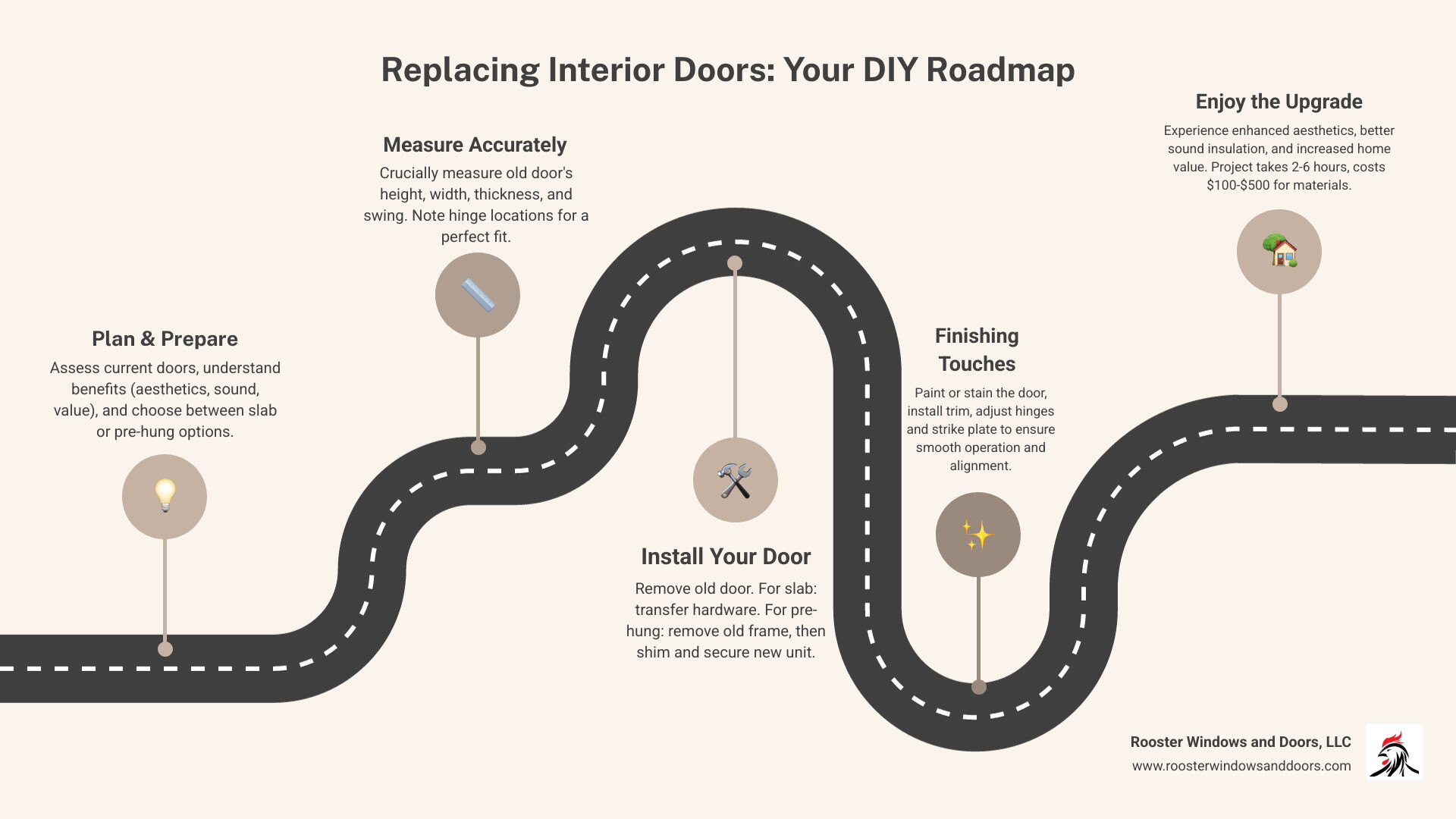Why Replacing Interior Doors Can Transform Your Home
Replacing interior doors is one of the most impactful home improvements you can make. It can improve your home’s aesthetics, provide better sound insulation, and increase property value. You’ll know it’s time to replace your doors if they are difficult to open, visibly damaged, or simply outdated. You can choose between replacing just the door slab or installing a complete pre-hung unit. The process typically takes 2-6 hours per door and costs $100-$500 for materials, depending on your choice. With over two decades of experience, we at Rooster Windows and Doors have seen how this project can transform a home. This guide will walk you through every step.

Preparation: What to Know Before You Start
Before you begin, gather the right tools and materials to ensure the project goes smoothly.
Essential Tools & Materials:
- Tools: Tape measure, level, pencil, circular or hand saw, utility knife, power drill with bits, hole saw kit, chisel set, hammer, pry bar, sawhorses, and safety glasses.
- Materials: Your new door (slab or pre-hung), hinges, lockset, wood screws, shims, sandpaper, and your choice of paint or stain.
Time & Cost:
- Time: A first-timer should budget 2-6 hours per door.
- Cost: A new door typically costs between $100 and $500. Professional installation can add $100 to $800 per door, depending on the complexity.
Choosing the Right Door for Your Home
Selecting the right door involves considering its construction and how it will be installed.
Slab vs. Pre-hung Doors:
- Slab Door: This is just the door panel. It’s a good choice if your existing door frame is in great shape. You’ll need to mortise the hinges and drill for the hardware yourself, which requires precision.
- Pre-hung Door: This is a complete unit with the door already hanging in its frame. It’s ideal for new construction or when the old frame is damaged. Installation is more involved but ensures a perfect fit.
Comparing Hollow-Core and Solid-Core Doors:
| Feature | Hollow-Core Doors | Solid-Core Doors |
|---|---|---|
| Cost | Lower ($50 – $150) | Higher ($150 – $500+) |
| Weight | Lightweight, easy to handle | Heavy, may require two people to install |
| Sound Insulation | Minimal | Excellent, significantly reduces noise transfer |
| Durability | Prone to dents and damage | Highly durable and resistant to wear and tear |
| Feel | Feels light and less substantial | Feels solid and high-quality |
| Best For | Closets, low-traffic areas | Bedrooms, bathrooms, offices, high-traffic areas |
For a deeper dive into how door construction influences acoustics, check out this helpful overview of soundproofing.
Step-by-Step Guide for Replacing Interior Doors
Now for the fun part: installing your new door. The process differs slightly depending on whether you’re working with a slab or a pre-hung unit.
Path 1: How to Install a New Door Slab
If your existing door frame is in good shape, installing a new slab is a great option.
1. Remove the Old Door:
Use a hammer and a nail set to tap out the hinge pins, starting from the bottom. Lift the old door off its hinges.
2. Prepare the New Slab:
- Template: Lay the old door on top of the new slab to use as a template.
- Trim to Fit: Measure the door opening. Your new door should be about 1/8 inch smaller on the top and sides, and have about a 1/2 inch gap at the bottom. Use a circular saw with a fine-toothed blade for a clean cut.
- Mark & Mortise for Hinges: Transfer the hinge locations from the old door to the new one. Carefully chisel out the marked areas so the hinge plates sit flush with the door’s edge.
- Drill for Hardware: Use a door lock installation kit to drill holes for the doorknob and latch.
3. Hang the New Door:
Attach the hinges to the new door, then hang it in the frame. Insert the hinge pins, starting from the top. Test the swing and make sure it closes smoothly.
Path 2: How to Install a Pre-hung Door
A pre-hung door is a complete unit with the door already in its frame. This is ideal if your old frame is damaged.
1. Remove the Old Door and Frame:
Take the old door off its hinges. Then, carefully pry the old door frame and trim away from the wall.
2. Prepare the Opening:
Ensure the rough opening is plumb (vertically straight) and level (horizontally straight).
3. Install the New Unit:
- Position: With a helper, place the new pre-hung unit into the opening.
- Shim: Use wood shims to create a snug fit between the new frame and the wall studs, ensuring the frame is perfectly plumb and level.
- Secure: Nail the frame into the wall studs through the shims.
- Test: Open and close the door to check for a smooth, even swing.
4. Install Hardware and Finish:
Install the doorknob, latch, and strike plate. Fill any nail holes, sand, and then paint or stain your new door and frame to complete the project.
Finishing Touches and Final Adjustments
With the door hung, a few final steps will ensure a professional look and smooth operation.
- Paint or Stain: For the best results, paint or stain the door before installation. Lay it flat to prevent drips. A durable semi-gloss paint is a great choice for interior doors. Always use a primer first for a long-lasting finish.
- Install Trim: If you installed a new frame, attach the trim (casing) around the door. Aim for a consistent reveal (the space between the frame and the trim) for a clean, professional look.
- Fill Nail Holes: Use wood putty or spackle to fill any nail holes in the trim. Sand smooth once dry before painting.
- Adjust the Strike Plate: If the door rattles or doesn’t latch properly, you may need to adjust the strike plate on the door frame. Loosen the screws and move it slightly, or gently bend the metal tab to tighten the fit.
Troubleshooting Common Issues
- Door Sticks or Rubs: Identify the high spot and sand or plane it down.
- Uneven Gaps: Add thin cardboard shims behind the hinges to adjust the door’s position.
- Door Sags: Replace a screw in the top hinge with a longer 3-inch screw that anchors into the wall stud.
- Mortise Too Deep: If you cut the hinge recess too deep, place a piece of cardboard behind the hinge plate to make it flush.
Frequently Asked Questions about Replacing Interior Doors
Here are answers to some common questions about replacing interior doors.
Can you replace an interior door without replacing the frame?
Yes, this is called installing a “slab door.” If your existing frame is in good condition, you can simply replace the door panel. This requires transferring the hinge and hardware locations from the old door to the new one, which involves some precise cutting and drilling, but avoids the need to replace the entire frame.
What is the difference between a solid-core and a hollow-core door?
Hollow-core doors are lightweight and affordable, with a cardboard or plastic honeycomb interior. They offer minimal sound insulation. Solid-core doors have a dense wood or composite core, making them heavier, more durable, and much better at blocking sound. They are ideal for bedrooms, bathrooms, and offices where privacy and noise reduction are important.
How much does it cost to replace an interior door?
The cost depends on the door type and whether you do it yourself. A new door slab can range from $100 to $500. Professional installation typically adds $100 to $800 per door, depending on the complexity of the job. A complete DIY project, including hardware and supplies, often averages around $230 per door.
What tools and materials are needed for replacing an interior door?
Key tools include a tape measure, level, drill, saw, and chisel set. You’ll also need materials like the new door, hinges, a lockset, screws, and paint or stain. Having everything ready before you start will make the process much smoother.
How do you measure for a new interior door?
Measure the width of the door opening at the top, middle, and bottom, and use the smallest measurement. Do the same for the height. Also, measure the door’s thickness (usually 1 ⅜ inches). For a slab door, you’ll need to measure the exact placement of the hinges and doorknob. Finally, determine the door swing: facing the door, if the hinges are on the left, it’s a left-hand door; if on the right, it’s a right-hand door.
What are common issues encountered during door replacement and how can they be fixed?
Common issues include:
- Sticking Door: Sand or plane the area where it rubs against the frame.
- Uneven Gaps: Add shims behind the hinges to adjust the door’s position.
- Rattling Door: Gently bend the metal tab on the strike plate for a tighter fit.
- Deep Hinge Mortise: Place a cardboard shim in the mortise under the hinge.
- Sagging Door: Replace a top hinge screw with a longer one that goes into the wall stud.
When is it time to replace an interior door?
You should consider replacing your interior doors if they are difficult to open or close, have visible damage like cracks or warping, or if their style is outdated. Poor sound insulation is another key reason for an upgrade. Most doors last 20-50 years; if yours are in that range and showing wear, a replacement can significantly improve your home’s look and feel.
Your Project Is Complete—Or Is It?
Congratulations on completing a rewarding home improvement project! Replacing interior doors can dramatically transform your home’s aesthetic, improve sound insulation, and increase its value.
While this guide provides the steps for a successful DIY installation, we understand that precision is key. If you prefer a guaranteed, professional finish, the experts at Rooster Windows and Doors are here to help. We serve Chicagoland, including Libertyville, Arlington Heights, and Naperville, ensuring flawless and efficient door installations.
Contact us today to learn more about our professional door installation services and let us bring your vision to life.



